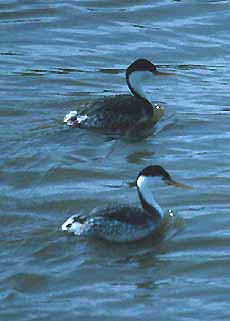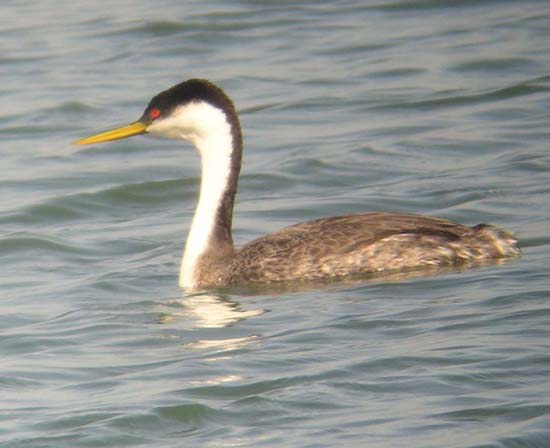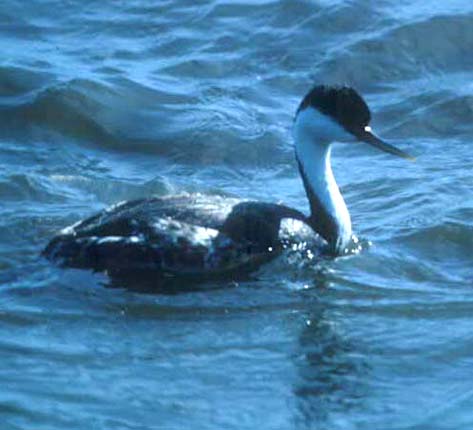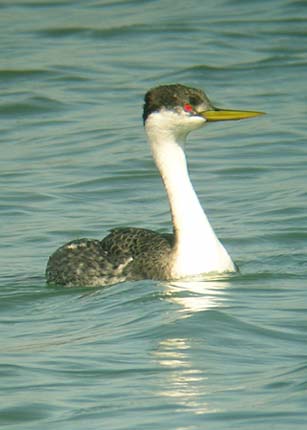 Separating
Western and Clark's Grebes is not always easy. They usually occur together
in the same flocks, and Clark's is generally identified by its orange-yellow
bill, but the fact that the eye is in the white part of the face, by paler
flanks, and by a narrower black stripe connecting the crown with the back.
But Clark's Grebes in fall and winter (in basic or juvenal plumages) can
be problematic since dark often appears around the eye and bill colors
less in intensity. There is still much to be worked out between the two
sibling species when in that ambiguous plumage. It is possible that the
grebe above right, and labeled "Western" here, is actually a Clark's Grebe.
For more information see Ratti (1979), Nuechterlein (1981), Storer &
Nuechterlein (1992), and Eckert (1995). Separating
Western and Clark's Grebes is not always easy. They usually occur together
in the same flocks, and Clark's is generally identified by its orange-yellow
bill, but the fact that the eye is in the white part of the face, by paler
flanks, and by a narrower black stripe connecting the crown with the back.
But Clark's Grebes in fall and winter (in basic or juvenal plumages) can
be problematic since dark often appears around the eye and bill colors
less in intensity. There is still much to be worked out between the two
sibling species when in that ambiguous plumage. It is possible that the
grebe above right, and labeled "Western" here, is actually a Clark's Grebe.
For more information see Ratti (1979), Nuechterlein (1981), Storer &
Nuechterlein (1992), and Eckert (1995).
All photos © D. Roberson. Top 6 Mar 2004 Elkhorn
Slough; above left Mar 1986 Moss Landing; above right 6 Mar 2004 Elkhorn
Slough; left (both species) 5 Apr 1991 Moss Landing harbor; below 14 Nov
2004 Monterey Harbor. |



 Separating
Western and Clark's Grebes is not always easy. They usually occur together
in the same flocks, and Clark's is generally identified by its orange-yellow
bill, but the fact that the eye is in the white part of the face, by paler
flanks, and by a narrower black stripe connecting the crown with the back.
But Clark's Grebes in fall and winter (in basic or juvenal plumages) can
be problematic since dark often appears around the eye and bill colors
less in intensity. There is still much to be worked out between the two
sibling species when in that ambiguous plumage. It is possible that the
grebe above right, and labeled "Western" here, is actually a Clark's Grebe.
For more information see Ratti (1979), Nuechterlein (1981), Storer &
Nuechterlein (1992), and Eckert (1995).
Separating
Western and Clark's Grebes is not always easy. They usually occur together
in the same flocks, and Clark's is generally identified by its orange-yellow
bill, but the fact that the eye is in the white part of the face, by paler
flanks, and by a narrower black stripe connecting the crown with the back.
But Clark's Grebes in fall and winter (in basic or juvenal plumages) can
be problematic since dark often appears around the eye and bill colors
less in intensity. There is still much to be worked out between the two
sibling species when in that ambiguous plumage. It is possible that the
grebe above right, and labeled "Western" here, is actually a Clark's Grebe.
For more information see Ratti (1979), Nuechterlein (1981), Storer &
Nuechterlein (1992), and Eckert (1995).
